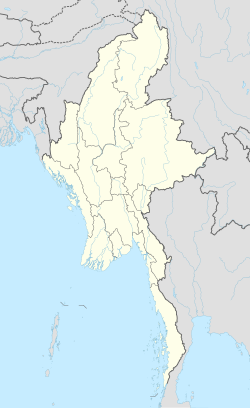
Dawei is a city in south-eastern Myanmar and is the capital of the Tanintharyi Region, formerly known as the Tenasserim Division, on the northern bank of the Dawei River. The city is about 614.3 km (381.7 mi) southeast of Yangon. Its population is 146,964. Dawei is a port at the head of the Dawei River estuary, 30 km (18.6 mi). from the Andaman Sea. As a result, the city is prone to flooding during the monsoon season. "Dawei" is also the name of one of Myanmar's 135 ethnic minorities.

Myeik is a rural city in Tanintharyi Region in Myanmar (Burma), located in the extreme south of the country on the coast off an island on the Andaman Sea. As of 2010, the estimated population was over 209,000. Myeik is the largest city in Tanintharyi Region, and serves as the regional headquarters of Myanmar Navy's Tanintharyi Regional Command. The area inland from the city is a major smuggling corridor into Thailand. The Singkhon Pass, also known as the Maw-daung Pass, has an international cross-border checkpoint.

Tanintharyi Region is an administrative region of Myanmar, covering the long narrow southern part of the country on the upper Malay peninsula, reaching to the Kra Isthmus. It borders the Andaman Sea to the west and the Tenasserim Hills, beyond which lie Thailand, to the east. To the north is the Mon State. There are many islands off the coast, the large Mergui Archipelago in the southern and central coastal areas and the smaller Moscos Islands off the northern shores. The capital of the division is Dawei (Tavoy). Other important cities include Myeik (Mergui) and Kawthaung. The division covers an area of 43,344.9 square kilometres (16,735.6 sq mi), and had a population of 1,406,434 at the 2014 Census.

Kyunsu or Kanmaw Township is a township of Myeik District in the Taninthayi Division of Myanmar. The principal town is Kyunsu. The township constitutes much of the Mergui Archipelago to the west, northwest and southwest of the city of Mergui (Myeik). The main town is located on the north-east coast of Kanmaw Island to the southwest of Mergui city.
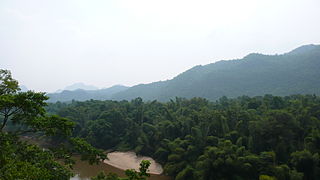
The Tenasserim Hills or Tenasserim Range is the geographical name of a roughly 1,700 km long mountain chain, part of the Indo-Malayan mountain system in Southeast Asia.
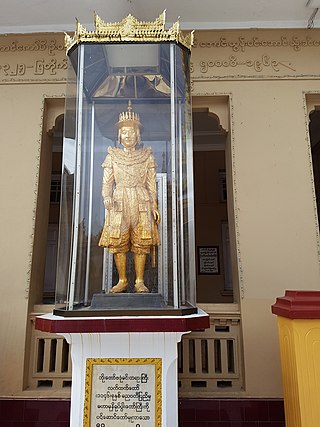
Thado Minsaw, also known as Shwedaung Min (ရွှေတောင်မင်း), was heir-apparent of Burma from 1783 to 1808, during the reign of his father King Bodawpaya of Konbaung dynasty. As Prince of Shwedaung and Dabayin, he was entrusted by the king to manage the day-to-day affairs of the kingdom, and when necessary, to lead the Royal Army against enemies. Thado Minsaw is best known for his conquest of Arakan in 1784–1785 and the subsequent removal of Mahamuni Buddha from Mrauk-U to Amarapura. He also led the successful defense of Tenasserim (Taninthayi) coast in 1792 in the war with Siam. The crown prince also led the revitalization of Burmese theater in the late 18th century by bringing a group of young artists to his court.
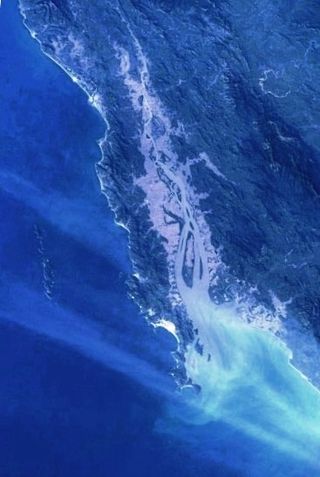
The Dawei River or Tavoy River is a river of the Tanintharyi Region, Burma.
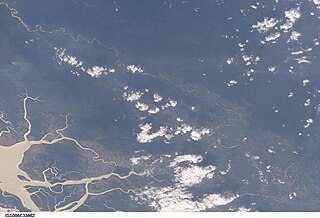
The Great Tenasserim River or the Tanintharyi River is a major river of southeastern Burma. It flows through the Tanintharyi Region, past the town of Tanintharyi, and enters the sea at Myeik (Mergui). The river rises from the Tenasserim Range at an altitude of 2,074 m (6,804 ft), and flows into the Andaman Sea. The region formed by this river is also known as Tenasserim, or Tanintharyi in Burmese. It is in a constricted coastal region in southeastern Myanmar, which borders Thailand on the east and the Andaman Sea on the west.

Kanmaw Kyun or Kanmaw Island is an island in the Andaman Sea along the coast of southeastern Burma (Myanmar), and is part of the Mergui Archipelago. Administratively, it is located in Kyunsu Township, Myeik District, in the Taninthayi Region. On the northeastern side of the island is the town of Kyunsu, which is the administrative seat for the township. The island covers a total area of 409 km2.

The Burmese–Siamese War (1759–1760) was the first military conflict between the Konbaung dynasty of Burma (Myanmar) and the Ban Phlu Luang Dynasty of the Ayutthaya Kingdom of Siam. It reignited the centuries-long conflict between the two Southeast Asian states that would last for another century. The Burmese were "on the brink of victory" when they suddenly withdrew from their siege of Ayutthaya because their king Alaungpaya had fallen ill. He died three weeks later, ending the war.
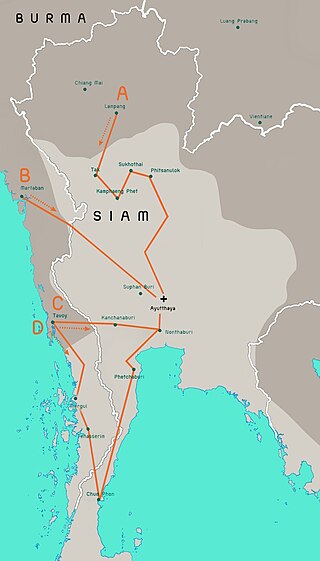
The Burmese–Siamese War (1765–1767), also known as the fall of Ayoudhia (အယုဒ္ဓယပျက်ခန်း) was the second military conflict between the Konbaung dynasty of Burma (Myanmar) and the Ban Phlu Luang dynasty of the Ayutthaya Kingdom of Siam, and the war that ended the 417-year-old Ayutthaya Kingdom. Nonetheless, the Burmese were soon forced to give up their hard-won gains when the Chinese invasions of their homeland forced a complete withdrawal by the end of 1767. A new Siamese dynasty, to which the current Thai monarchy traces its origins, emerged to reunify Siam by 1771.
The Myeik dialect, also known as Beik in Burmese, Mergui and Merguese in English, and Marit (มะริด) in Thai, is a divergent dialect of Burmese, spoken in Myeik, the second largest town in Tanintharyi Region, the southernmost region of Myanmar. Myeik shares many commonalities with the Tavoyan dialect, although there are substantial differences especially with regard to phonology.
Phu Nam Ron is a pass across the Tenasserim Hills on the border between Thailand and Myanmar, at an elevation of 350 metres (1,150 ft). The border checkpoint on the Thai side is in Ban Kao Subdistrict, Mueang Kanchanaburi District, Kanchanaburi Province.
Myitta Subtownship is a subtownship of Dawei Township, Dawei District in the Taninthayi Division of Myanmar. The main town is Myitta (Matamyu), located on the western side of the Tenasserim Range near the confluence of two tributaries of the Great Tenasserim River.
Sinbyudaing, is a small village of Dawei District in the Taninthayi Region of Myanmar. It is located on the western side of the Tenasserim Range near the border with Thailand.
Amya is a village of Dawei District in the Taninthayi Division of Myanmar.
Kyaukton, is a village of Dawei District in the Taninthayi Division of Myanmar. It is located on the western side of the Tenasserim Range, 24 km to the northwest of Sinbyudaing.

Lei Lei Maw is a Burmese politician and a medical doctor who served as Chief Minister of Tanintharyi Region and Taninthayi Region Parliament MP for Thayetchaung Township Constituency No. 1. She was removed from her chief minister position for corruption on 11 March 2019. She is the second of only two women chief ministers appointed by President Htin Kyaw.
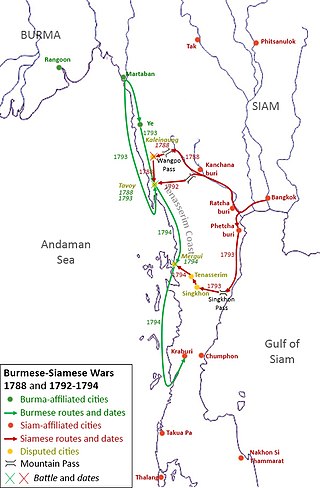
The Burmese–Siamese War (1792–1794) or the Siamese Invasion of Tavoy was the conflict between the Kingdom of Burma under Konbaung dynasty and the Kingdom of Siam under the Chakri dynasty over the town of Tavoy and the Tenasserim Coast.

The Tavoy campaign of 1788 was a conflict between the Kingdom of Burma under Konbaung dynasty and the Kingdom of Siam under the Chakri dynasty over the town of Tavoy and the Tenasserim Coast.
